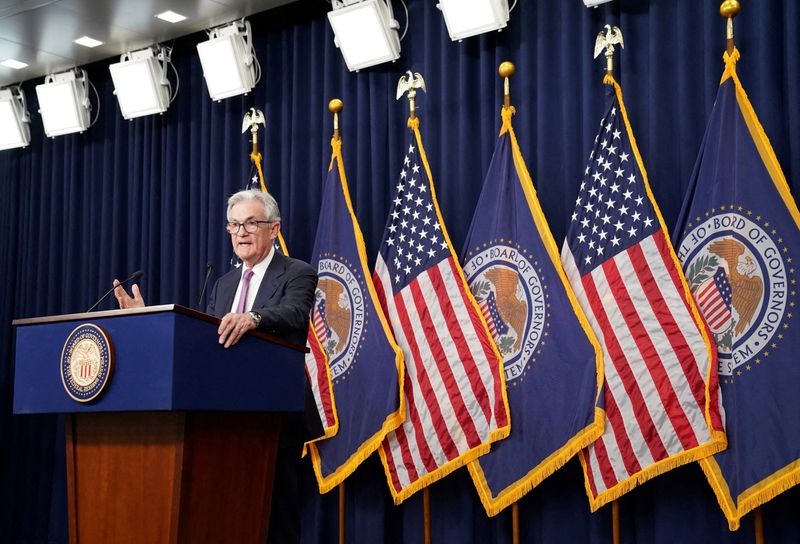By Michael S. Derby
(Reuters) - Less tight financial conditions as exhibited by the red-hot stock market may increase the chances that the Federal Reserve hikes rates again before the end of the year, some economists reckon, even as financial markets put little odds on that happening.
Several measures of financial conditions, including those mceproduced by the central bank, have shifted in way that signals reduced restraint on the economy, at a time when central bank officials believe more work may be needed to lower inflation.
Taking in to account everything from stock prices to measures of borrowing costs for the government, businesses and households, financial conditions matter to monetary policy. That is because the Fed relies on markets to transmit changes in its short-term interest rate target to the broader economy.
The current slackening in these gauges means markets and the Fed are starting to go on separate paths.
“Easy financial conditions obviously boost near-term growth,” and can encourage more risk-taking of the sort that can lean against the restraint the Fed is trying to impose on the economy, said Benson Durham, head of global policy at Piper Sandler.
On Friday, the Federal Reserve reported that its Financial Conditions Impulse on Growth for June moved to 0.458, from May’s 0.603 reading. The index, now the lowest since August 2022, seeks to describe whether financial conditions are aiding or restraining growth, so the latest reading points to them providing less drag on the economy.
Meanwhile, Goldman Sachs’ closely watched Financial Conditions Index has been easing fairly steadily since May. As of the end of July, that measure was also at levels last seen in late August of last year, while the Chicago Fed’s latest index has also pointed to easier conditions.
Since March of last year, the Fed has been engaged in a historically aggressive campaign of short-term interest rate increases, taking its target rate from near zero levels to between 5.25% and 5.5% after a quarter percentage-point increase on Wednesday.
An explicit goal has been to tighten financial conditions. Mortgage rates have soared to around 7%, while other borrowing costs are up. Rate hikes also slammed the stock market, at least for a time, while pushing up the dollar relative to other currencies.
Tighter financial conditions have helped accomplish the Fed’s desire to slow down the economy in a bid to lower inflation pressures from multi-decade highs. But now things are shifting the other way, which could create issues for the Fed as it approaches the endgame for its tightening cycle.
FED WILL 'GET TO WHERE WE NEED TO GO'
The various gauges on balance show financial conditions reached their most restrictive levels late last year, and have receded since. That dovetails with a stock market rally that has pushed up the benchmark S&P 500 Index by nearly 20% so far this year. Meanwhile, yields on the riskiest corporate debt securities - so-called junk bonds - have fallen by about 1.2 percentage points since last autumn even as the Fed kept raising interest rates.
Fed Chair Jerome Powell, who has regularly faced questions about financial market expectations diverging from officials’ outlooks, brushed off easier financial conditions in this week's press conference that followed the Federal Open Market Committee meeting. He attributed easier financial conditions to the stock market rally and a weaker dollar, and appeared to view the current situation as one that will work itself out over time.
“We will do what it takes to get inflation down and in principle, that could mean that if financial conditions get looser, we have to do more,” Powell said. “But what tends to happen, though, is financial conditions get in and out of alignment with what we're doing, and ultimately over time we get where we need to go.”
Powell noted in the press conference that it is a tossup as to whether the Fed raises rates or holds steady in September. He offered no views on whether the central bank will be able to boost by another quarter percentage point by year’s end, as June FOMC forecasts predicted.
Piper Sandler's Durham said the easier financial conditions make the odds of another rate rise higher by year’s end, in contrast with the current market outlook. This easing gives officials “the space and the breathing room” to bump rates up again, especially in an economy that is otherwise doing very well despite aggressive increases.

Bank of America (NYSE:BAC) economists said in a note on Thursday that they believe market pricings show an underestimation of what the central bank needs to do on rates. They said easing inflation in the face of still-strong jobs data and better-than-expected growth “are likely to keep the Fed worried that its policy stance is insufficiently restrictive.”
Still, the Fed may yet find space not to hike rates again. Even as many key aspects of the economy have remained strong in the face of higher rates, inflation pressures are easing. On Friday, the government reported that inflation pressures last month and employment costs in second quarter eased.